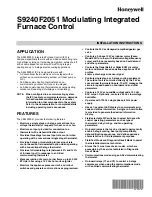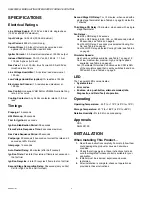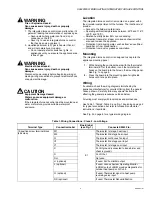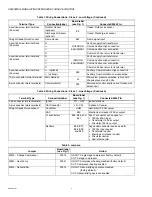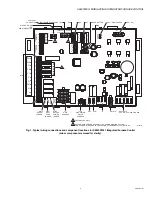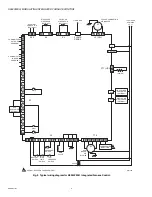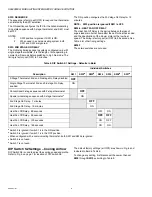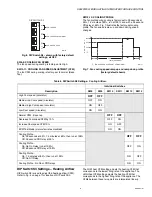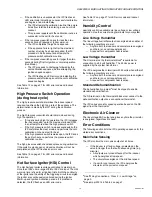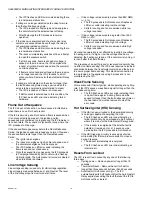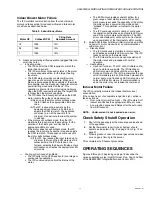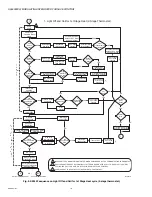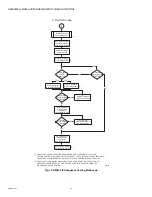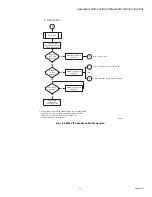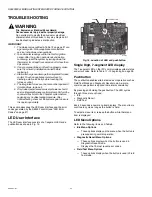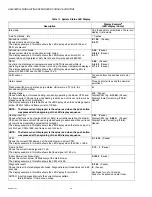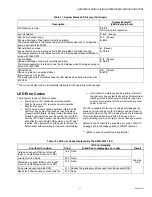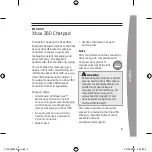
S9240F2051 MODULATING INTEGRATED FURNACE CONTROL
15
69-2807—01
— If the calibration is unsuccessful, the IFC flashes an
LED error code indicating an unsuccessful calibration
and begins a five minute delay.
• The IFC attempts the calibration routine three more
times (four total) before entering a one hour Soft
Lockout.
• This process repeats until the calibration routine is
successful or the call for heat ends.
— If the low pressure switch opens for less than two
seconds during Prepurge or Igniter warm-up:
• The IFC completes the ignition sequence.
• If the appliance fails to light after the maximum
number of retries has been exceeded, the IFC
proceeds to Soft Lockout and attempts the
pressure switch calibration routine.
— If the low pressure switch opens for longer than two
seconds during Trial for Ignition or normal operation
(Run Mode):
• The IFC proceeds to Postpurge followed by the
vent calibration sequence, before attempting the
ignition sequence again.
• The IFC flashes an LED error code indicating the
pressure switch failed open until the vent calibration
sequence begins.
See Table 12 on page 27 for LED error code and lockout
information.
High Pressure Switch Operation
(during heat cycle)
The high pressure switch determines the inducer speed
required to achieve the high firing rate of the appliance. The
determination is made by the IFC during the calibration
process.
The high fire pressure switch should remain closed during
high fire operation.
— If it opens during high fire operation, the IFC increases
the inducer speed, up to the maximum allowed RPM,
in an attempt to re-close the high pressure switch.
— If the high pressure switch re-closes successfully, the
IFC completes the Heat mode, and performs the vent
calibration on the next call for heat.
— If the high pressure switch remains open, the IFC ends
the call for heat and performs the pressure switch
calibration routine.
The high pressure switch check takes place during calibration.
If the switch is stuck open or closed, calibration will not be
completed and the IFC flashes an error code.
See Table 12 on page 27 for LED error code and lockout
information.
Hot Surface Igniter (HSI) Control
The Hot Surface Igniter is voltage controlled to maintain no
more than 120V over a range of 98 to 132V line input. The HSI
warm up time is fixed for all ignition trials. Both the continuity
of the igniter and the ability of the triggering circuit to energize
the igniter are continuously monitored during the Igniter
Warm-up and Ignition Activation periods. If a problem is
detected, the IFC flashes an LED error code.
See Table 12 on page 27 for LED error code and lockout
information.
Humidity Control
Humidity control is available via line voltage or low voltage
operation. Use the correct wiring terminals for your system.
Line Voltage Humidifier
The line voltage humidifier output is energized when either of
the following conditions are met:
— Anytime both the inducer and circulator are energized
and there is no cool request present.
— A request for compressor heat is active.
Low Voltage Humidifier
The H terminal on the thermostat block
a
is available for
connection to a 24 volt humidifier. The 24 Vac power is
supplied by the system transformer.
The IFC energizes the H terminal with 24 volts when either of
the following conditions are met:
— Anytime both the inducer and circulator are energized
and there is no cool request present.
— A request for compressor heat is active.
Standard Dehumidification
The dehumidification jumper
b
must be clipped to enable
standard dehumidification.
The DS terminal on the thermostat block must connect to the
dehumidification output on a conventional thermostat.
The IFC varies circulator speed operation based on the DS
signal from the thermostat.
Electronic Air Cleaner
The line voltage EAC output energizes anytime the circulator
is energized, regardless of speed.
Error Conditions
The following section lists the IFC operating sequence for the
stated error conditions.
Main Valve Sensing
The IFC monitors the main valve output at all times.
— If the inducer is off and voltage is detected on the
valve for longer than the fault debouncing time (e.g.
miswire):
• All outputs are turned off except for the inducer,
which energizes at low speed.
• The circulator energizes at the mid heat speed.
• If a call for cool occurs, the IFC energizes the
circulator at the correct cool speed.
a
See “Wiring Connections - Class 2 - Low Voltage.” on
b
See jumper W914 in Table 4 on page 7.

